Intel Unveils Moorestown and the Atom Z600, The Fastest Smartphone Platform?
by Anand Lal Shimpi on May 4, 2010 11:54 PM EST- Posted in
- Smartphones
- Intel
- Atom
- Mobile
- SoCs
Moorestown: The Two Chip Solution That Uses Five Chips
Intel calls Moorestown a two-chip solution. That’s the Lincroft SoC and the Langwell IO Hub. Intel says there’s no architecture limitation for splitting these two up, it was just a way of minimizing risk. You put the bulk of the 3rd party technologies in the Langwell IO Hub and keep the important, mostly Intel controlled components in Lincroft. This is still the first SoC that Intel is going to market with, so splitting the design into two chips makes sense. The followon to Moorestown, codenamed Medfield, will integrate these two once Intel is comfortable.

The 45nm, 140M transistor Lincroft die
Lincroft houses the CPU, GPU and memory controller and is built on Intel’s 45nm process. This isn’t the same 45nm process used in other Intel CPUs, instead it’s a special low power version that trades 6 - 8% performance for a 60% reduction in leakage. The tradeoff makes sense since the bulk of these chips will run at or below 1.5GHz. And by the way, it’s now called the Atom Z600 series.
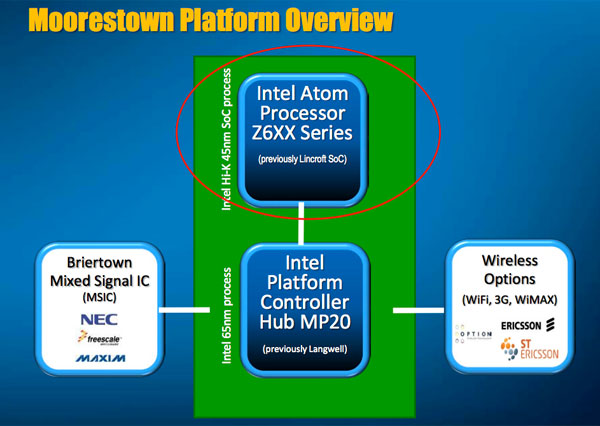
| Transistor Comparison | |||||
| Intel Atom Z5xx Series | Intel Atom Z6xx Series | NVIDIA Tegra 2 | |||
| Manufacturing Process | 45nm | 45nm | 40nm | ||
| Transistor Count | 47M | 140M | 260M* | ||
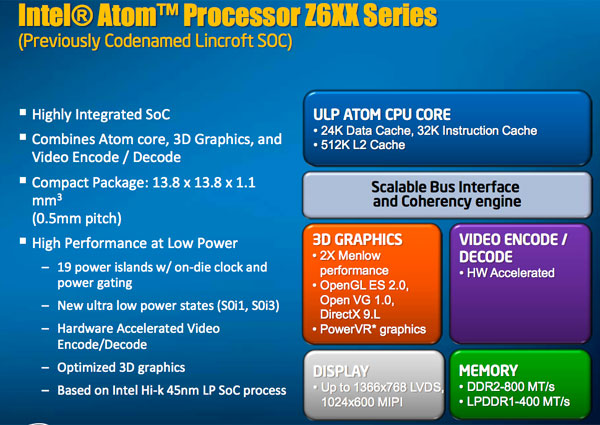
Langwell, now known as the Intel Platform Controller Hub (PCH) MP20, holds virtually everything else. It’s got an image processing core that supports two cameras (1 x 5MP and 1 x VGA), USB 2.0 controller, HDMI output (1080p) and a NAND controller that can support speeds of up to 80MB/s. The whole chip is managed by a 32-bit RISC core.
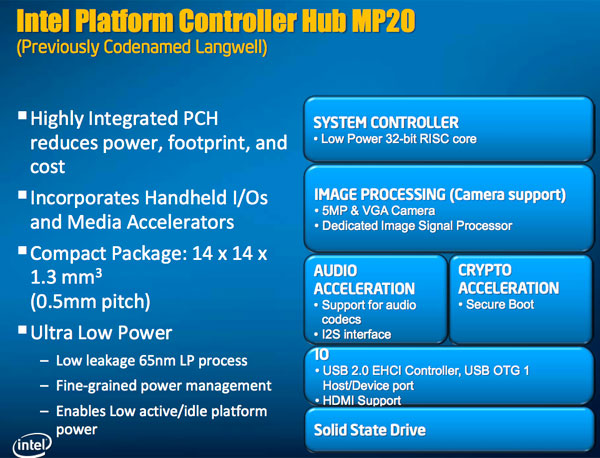
Langwell is a 65nm chip built at TSMC. TSMC has existing relationships with all of the IP providers for the blocks inside Langwell, so making it at TSMC is a sensible move (a temporary one though, with Medfield Intel will integrate all of this).
and_PlatformControllerHub_package2_sm.jpg)
Langwell (left) and Lincroft (right)
While Lincr, err, Atom Z600 and the Intel PCH MP20 are enough for a traditional system, they are not enough for a smartphone. You need wireless radios, that’s one chip for WiFi and one for 3G support. You need something to handle things like power management, charging the battery and controlling the touch screen. That’s an additional chip, called Briertown.
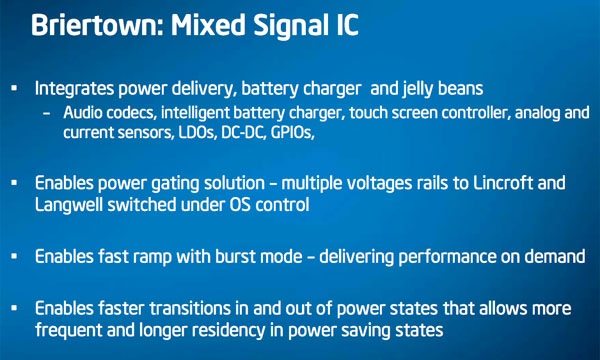

We’re up to four chips at this point, but you need at least one more. While modern day smartphone SoCs ship with on-package memory, Intel doesn’t yet support that. Obviously it’s not impossible to do, Marvell, TI, Qualcomm and Samsung do it with all of their SoCs. Look inside Apple’s iPad and you won’t see any DRAM chips, just a Samsung part number on the application processor package. Intel doesn’t have the same experience in building SoCs and definitely not in integrating memory so it’s not a surprise we don’t have that with Moorestown. Unfortunately this means a smartphone manufacturer will need as many as five discrete chips to support Moorestown.
| Platform Size | |||||
| Moorestown | |||||
| CPU + Chipset | 387 mm2 | ||||
| Total Platform Area | 4200 mm^2 | ||||
| SoC Package Size | 13.8 mm x 13.8 mm x 1.0 mm | ||||
| PCH Package Size | 14 mm x 14 mm x 1.33 mm | ||||
And now we know why Intel has been showing off its extremely long form factor prototype all this time:
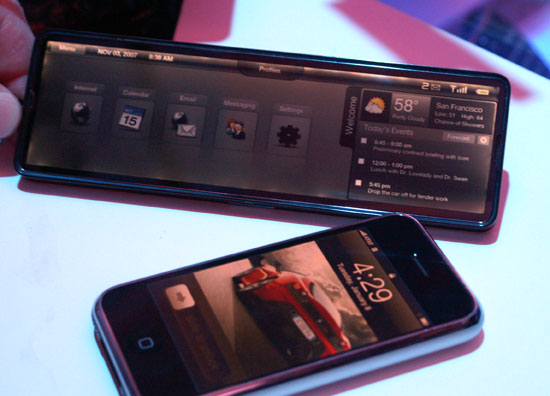










67 Comments
View All Comments
Suhail_kapoor - Wednesday, May 5, 2010 - link
Anand, Intel said 3 out of 5, you said one magic device, I think they have one sorted out ... NOKIA is a company needing revolution and this partnership is Nokia's hope for smart phone market.Also outside US and to some extent Europe Nokia has a very strong foot hold, combined with essentially free software such as MeeGo the road looks good, only IF and a big if, they can deliver on software front.
WaltFrench - Sunday, May 9, 2010 - link
“…NOKIA is a company needing revolution and this partnership is Nokia's hope for smart phone market.”Only problem: Nokia needs a polished solution fast—its average sales price is imploding and the shareholders are restless. A solution that would require them to throw away all the development work to date would be suicidal.
If it takes 12-24 months to implement a totally new architecture, with new software (seems a bit optimistic), only a smartphone maker whose roadmap is in great shape today can afford to make the switch; that'd be Apple. But they have just bulked up with PA Semi and Intrinsity; it'd be hard to imagine much Intel Inside.
Not to mention that Intel's i-series CPUs seem to have been designed to derail Apple's plans of running with a graphics-centric, well-supported CPU. The extra silicon & design time seems to have kept the i3 out of Apple's 13" notebook, while the 15" and 17" have just-a-bit-rocky auto-switch technology to fire up the NVidia GPUs. It doesn't seem that Intel has exactly been courting Apple's product intentions of late.
Lord Banshee - Wednesday, May 5, 2010 - link
Intel First SoC based on Atom is not Moorestown, but CE4100(codename Sodaville) is: http://download.intel.com/design/celect/prodbrf/32...http://intelconsumerelectronics.com/
Where is the love for Intel's CE product. Anand you should look into reviewing some products based off these products too.
ganeshts - Wednesday, May 5, 2010 - link
Sure, is there a shipping product based on the CE3xxxx or CE4xxxx series?I remember there seemed to be something like the Yuixxx from Conceptronix or some similarly named Dutch company.. Did they ever ship?
Lord Banshee - Wednesday, May 5, 2010 - link
I am not sure what products have CE products in it... CE devices typically don't advertise this kind of info.Lots of rumors when searching for ce4100 on engadget
http://www.engadget.com/search/?q=ce4100&invoc...
ganeshts - Wednesday, May 5, 2010 - link
Most of those CE4100 results are Intel announcements announcing platform updates or availabilities.The TiVo Premier result, I am not sure why it is even there.... TiVo Premier teardown revealed it is fully Boradcom based, IIRC.
I am very interested to know whether there are any CE4100 products out in the hands of the customers right now... Any Intel employees / PR guys care to offer this information?
zdzichu - Wednesday, May 5, 2010 - link
Seeing that GPU part is descendant of Paulsbo... I foresee similar fiasco with opensource drivers as with GMA500. Too bad, it really damages Intel reputation.beginner99 - Wednesday, May 5, 2010 - link
funny gma 600. Even if intel like improves gm drivers 100x fold, they will still suck...So you can pretty much say it depends on that.And there go my dreams for useful drivers for my menlow device...it's a PITA. slowing hardware by deliberatley? making horrible drivers.
JumpingJack - Wednesday, May 5, 2010 - link
Intel's graphics performance as they begin integrating into the CPU improved significantly, to the point of competitive. http://www.anandtech.com/show/2952/2Your view point is strictly from a desktop running pixels number as high as 1900x1200 (too much for even the best IGP from nVidia or ATi/AMD), on a smartpone the graphic intensity is not nearly enough... it does not need to win on the highest FPS, it just needs to get 30 FPS or better for a fluid experience.
The graphics component should be fine, no real reason to suspect otherwise.
rahvin - Wednesday, May 5, 2010 - link
Given the abysmal Linux support of the GMA500 I foresee a complete piece of crap again that will result in this being used in NO android phones. For me Android is the future of the cellphone and frankly what happened with Paulsbro foreshadows the complete crap that this platform will be on Android and other Linux based platforms (like WebOS). The concerns of the OP are completely justified and I had exactly the same reaction when I read the GPU is based on PowerVR like the piece of crap GMA500.Intel cannot succeed in the Phone space if Linux is treated with the same disdain they presented with GMA500.